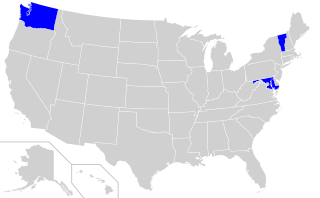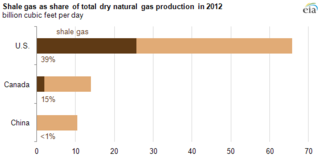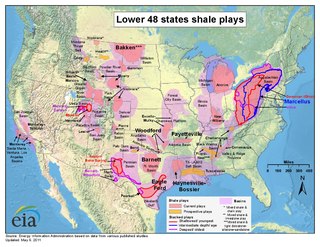Related Research Articles
Coterra Energy Inc. is a company engaged in hydrocarbon exploration organized in Delaware and based in Houston, Texas. The company has operations in the Permian Basin, Marcellus Shale, and the Anadarko Basin.

The Barnett Shale is a geological formation located in the Bend Arch-Fort Worth Basin. It consists of sedimentary rocks dating from the Mississippian period in Texas. The formation underlies the city of Fort Worth and underlies 5,000 mi² (13,000 km²) and at least 17 counties.

Fracking in the United States began in 1949. According to the Department of Energy (DOE), by 2013 at least two million oil and gas wells in the US had been hydraulically fractured, and that of new wells being drilled, up to 95% are hydraulically fractured. The output from these wells makes up 43% of the oil production and 67% of the natural gas production in the United States. Environmental safety and health concerns about hydraulic fracturing emerged in the 1980s, and are still being debated at the state and federal levels.
The British Columbia Energy Regulator (BCER), formerly the BC Oil and Gas Commission, is a British Columbia, Canada Crown Corporation, established in October 1998. It has offices in seven cities: Fort St. John, Fort Nelson, Kelowna, Victoria, Terrace, Dawson Creek, and Prince George.
Aera Energy LLC is a natural gas, oil exploration and production company started as a joint venture between Shell plc and Mobil. Headquartered in Bakersfield, California, Aera Energy LLC is a California limited liability company, and one of California's largest oil and natural gas producers, with an approximate 2015 revenues of over $2 billion. Aera is operated as a stand-alone company through its board of managers.

Shale gas is an unconventional natural gas that is found trapped within shale formations. Since the 1990s a combination of horizontal drilling and hydraulic fracturing has made large volumes of shale gas more economical to produce, and some analysts expect that shale gas will greatly expand worldwide energy supply.
The Ohio Department of Natural Resources (ODNR) is the Ohio government agency charged with ensuring "a balance between wise use and protection of our natural resources for the benefit of all."

Produced water is a term used in the oil industry or geothermal industry to describe water that is produced as a byproduct during the extraction of oil and natural gas, or used as a medium for heat extraction. Water that is produced along with the hydrocarbons is generally brackish and saline water in nature. Oil and gas reservoirs often have water as well as hydrocarbons, sometimes in a zone that lies under the hydrocarbons, and sometimes in the same zone with the oil and gas. In geothermal plants, the produced water is usually hot. It contains steam with dissolved solutes and gases, providing important information on the geological, chemical, and hydrological characteristics of geothermal systems. Oil wells sometimes produce large volumes of water with the oil, while gas wells tend to produce water in smaller proportions.

Shale gas in the United States is an available source of unconventional natural gas. Led by new applications of hydraulic fracturing technology and horizontal drilling, development of new sources of shale gas has offset declines in production from conventional gas reservoirs, and has led to major increases in reserves of U.S. natural gas. Largely due to shale gas discoveries, estimated reserves of natural gas in the United States in 2008 were 35% higher than in 2006.

The inclusion of unconventional shale gas with conventional gas reserves has caused a sharp increase in estimated recoverable natural gas in Canada. Until the 1990s success of hydraulic fracturing in the Barnett Shales of north Texas, shale gas was classed as "unconventional reserves" and was considered too expensive to recover. There are a number of prospective shale gas deposits in various stages of exploration and exploitation across the country, from British Columbia to Nova Scotia.

Fracking is a well stimulation technique involving the fracturing of formations in bedrock by a pressurized liquid. The process involves the high-pressure injection of "fracking fluid" into a wellbore to create cracks in the deep-rock formations through which natural gas, petroleum, and brine will flow more freely. When the hydraulic pressure is removed from the well, small grains of hydraulic fracturing proppants hold the fractures open.
Range Resources Corporation is a natural gas exploration and production company headquartered in Fort Worth, Texas. It operates in the Marcellus Formation, where it is one of the largest land owners.

Fracking in the United Kingdom started in the late 1970s with fracturing of the conventional oil and gas fields near the North Sea. It was used in about 200 British onshore oil and gas wells from the early 1980s. The technique attracted attention after licences use were awarded for onshore shale gas exploration in 2008. The topic received considerable public debate on environmental grounds, with a 2019 high court ruling ultimately banning the process. The two remaining high-volume fracturing wells were supposed to be plugged and decommissioned in 2022.

Fracking has become a contentious environmental and health issue with Tunisia and France banning the practice and a de facto moratorium in place in Quebec (Canada), and some of the states of the US.

Environmental impact of fracking in the United States has been an issue of public concern, and includes the contamination of ground and surface water, methane emissions, air pollution, migration of gases and fracking chemicals and radionuclides to the surface, the potential mishandling of solid waste, drill cuttings, increased seismicity and associated effects on human and ecosystem health. Research has determined that human health is affected. A number of instances with groundwater contamination have been documented due to well casing failures and illegal disposal practices, including confirmation of chemical, physical, and psychosocial hazards such as pregnancy and birth outcomes, migraine headaches, chronic rhinosinusitis, severe fatigue, asthma exacerbations, and psychological stress. While opponents of water safety regulation claim fracking has never caused any drinking water contamination, adherence to regulation and safety procedures is required to avoid further negative impacts.

The environmental impact of fracking is related to land use and water consumption, air emissions, including methane emissions, brine and fracturing fluid leakage, water contamination, noise pollution, and health. Water and air pollution are the biggest risks to human health from fracking. Research has determined that fracking negatively affects human health and drives climate change.

There are many exemptions for fracking under United States federal law: the oil and gas industries are exempt or excluded from certain sections of a number of the major federal environmental laws. These laws range from protecting clean water and air, to preventing the release of toxic substances and chemicals into the environment: the Clean Air Act, Clean Water Act, Safe Drinking Water Act, National Environmental Policy Act, Resource Conservation and Recovery Act, Emergency Planning and Community Right-to-Know Act, and the Comprehensive Environmental Response, Compensation, and Liability Act, commonly known as Superfund.

The Marcellus natural gas trend is a large geographic area of prolific shale gas extraction from the Marcellus Shale or Marcellus Formation, of Devonian age, in the eastern United States. The shale play encompasses 104,000 square miles and stretches across Pennsylvania and West Virginia, and into eastern Ohio and western New York. In 2012, it was the largest source of natural gas in the United States, and production was still growing rapidly in 2013. The natural gas is trapped in low-permeability shale, and requires the well completion method of hydraulic fracturing to allow the gas to flow to the well bore. The surge in drilling activity in the Marcellus Shale since 2008 has generated both economic benefits and considerable controversy.
Hydraulic fracturing is the propagation of fractures in a rock layer by pressurized fluid. Induced hydraulic fracturing or hydrofracking, commonly known as fracking, is a technique used to release petroleum, natural gas, or other substances for extraction, particularly from unconventional reservoirs. Radionuclides are associated with fracking in two main ways. Injection of man-made radioactive tracers, along with the other substances in hydraulic-fracturing fluid, is often used to determine the injection profile and location of fractures created by fracking. In addition, fracking releases naturally occurring heavy metals and radioactive materials from shale deposits, and these substances return to the surface with flowback, also referred to as wastewater.
AquaSalina is a salt de-icer made from produced water at Duck Creek Energy's vertical oil and gas wells. It is then filtered in Cleveland, Ohio and Mogadore, Ohio. The Ohio Department of Transportation approved AquaSalina in 2004, and it has been sold at Lowe's and elsewhere.
References
- ↑ "Our People". Duck Creek Energy.
- ↑ "Company". Nature's Own Source.
- 1 2 Kuzydym, Duane Pohlman & Stephanie. "Serious questions about radioactive element in highway de-icer". WKRC. Retrieved 22 January 2020.
The Ohio Department of Natural Resources (ODNR) tested AquaSalina for radioactivity and, in June and July of 2017, issued reports finding, on average, AquaSalina contains radium levels at 300 times higher than the federal standard for safe drinking water.
- ↑ McCarty, James F. (10 February 2019). "Radioactive road deicer rules under review by Ohio legislature; debate over public safety continues". The Plain Dealer.
Members of the state legislature rejected the reports' findings, introducing a law last year that would ease regulations on AquaSalina, treating it as a commodity rather than toxic waste derived from oil- and gas-drilling operations. The law would also prevent ODNR from imposing any additional requirements.
- ↑ Shingler, Dan (1 December 2013). "Calling a deicer 'toxic' leads to heated exchanges". Crain's Cleveland Business.
The court cited the difference, saying the product 'contains' fracking water as opposed to saying it 'is' fracking water. Statements the women made that AquaSalina is "toxic" or that it contains harmful levels of benzene also did not result in a judgment against them, in part because the court said those were matters of opinion. But the court did rule that the women were wrong to tell others that AquaSalina is fracking water, and that they made statements they knew or should have known were false. It found the women sent emails and that 'statements that AquaSalina is "frac water" or a by-product thereof were published with actual malice.'
- ↑ "Brecksville-based energy company wins defamation lawsuit". Akron Beacon Journal. November 11, 2013. Archived from the original on November 21, 2020. Retrieved February 23, 2020.
Duck Creek Energy, based in Brecksville, Ohio, created AquaSalina(TM) in 2003 and received approval for its use as a deicer and dust suppressant from the Ohio Department of Natural Resources in 2004.